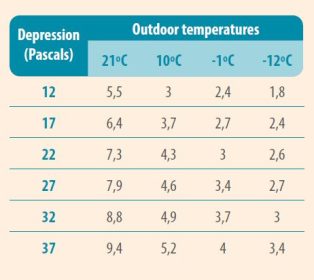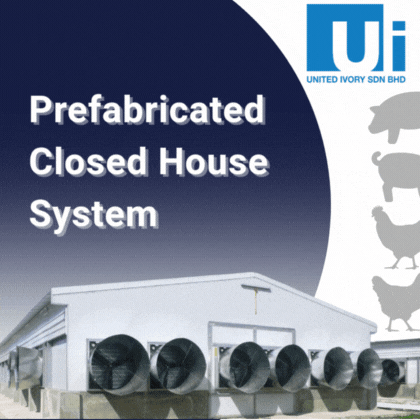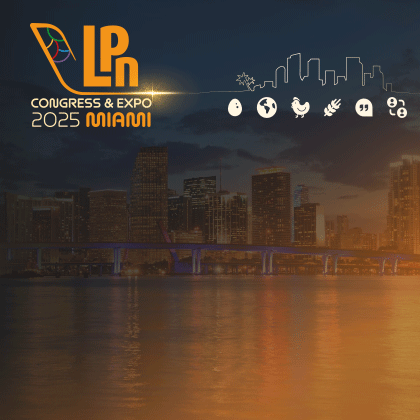Content available at: Indonesia (Indonesian) Melayu (Malay) ไทย (Thai) Tiếng Việt (Vietnamese) Philipino
Negative pressure ventilation is the most popular method for ventilating poultry farms in cold weather due to its simplicity and relatively low initial costs.
- Exhaust fans create negative pressure inside the house and give the poultry producer precise control over the amount of fresh air entering the house.
- The air inlets distribute the cold outside air, sucked in by the exhaust fans, evenly throughout the house and direct it along the ceiling, where the warm air (produced by the birds and the heating system) accumulates near the ceiling; so that the fresh air will be heated before it descends to the level of the birds.
It doesn’t matter if the house is 30 or 200 meters long; it doesn’t matter if the house is 9 or 18 meters wide; it doesn’t matter if the house has broilers, layers, breeders or ducks.
With adequate air inlets and the right level of negative pressure, it is relatively simple to provide fresh, warm air to all birds in a house with minimal cost and effort.
If the cold, heavy air entering through the hatches of a house does not enter with sufficient velocity, it will tend to fall rapidly to the floor as it enters the house, causing the chicks to cool and the litter to clump.
NEGATIVE PRESSURE VENTILATION
One of the most important features of negative pressure ventilation is that it gives the poultry producer control over the rate at which clean, cool outside air enters the house.
The goal during cold weather is to maximize the distance the incoming cool air travels along the ceiling before descending to bird level.
- The faster the air enters the house, the longer it will stay near the ceiling, the more it will mix with the warm air that accumulates near the ceiling and the less likely it is to cool the birds as it descends to the floor.
In addition, as the temperature of the incoming air increases, its ability to retain moisture increases, making it more effective at removing moisture from the bedding.
NEGATIVE PRESSURE VENTILATIONS AND DEPRESSION
In negative pressure ventilation, the depression determines the velocity of air entry through the house’s air inlets.
- The greater the depression, the faster the air will enter the house.
- The lower the depression, the slower the air enters the house.
The relationship between depression and air inlet velocity is very well defined.
- In fact, the depression of the house can be known by measuring the velocity of the air entering the house through a side wall hatch and using Graphic 1.

OPTIMAL DEPRESSION
It is often thought that the main factor determining the optimum depression for a house is the width of the house.
- It stands to reason that the wider the house, the greater the air velocity required for the incoming air to reach the center of the house and, therefore, the greater the required depression.
But, in reality, the main factor that determines the optimum depression is the cold outside, or more specifically, the difference in air temperature between the inside and outside of the house.
- This makes sense if we consider why we use air inlets… to keep the cold, heavy air close to the ceiling, and warm it up before it goes down to the floor.
If the incoming air is warm and relatively light, why is it going to fall to the ground?
- After all, if it is about the same temperature as the hot air in the house, it is not heavier than the air in the house and will therefore tend to stay close to the ceiling.
- However, if the incoming air is much cooler and therefore heavier than the house’s air, it will tend to fall to the ground quickly if it enters the house at low velocity.*
INCOMING AIR TRAJECTORY
Equations have been developed to predict the extent of air along the ceiling entering through a hatch before descending to ground level, as a function of various factors (e.g., static pressure, size of inlet opening, type of inlet, position of inlet, etc.).
Although they do not provide precise answers for every situation, these equations can be used to explore how factors such as indoor/outdoor temperature differences affect the path of incoming air.
For example, for a typical European-style hatch placed near a smooth ceiling, open 5 centimeters, at a static pressure of 27 pascals, the air sheet will travel approximately 8 meters along the ceiling before descending to floor level when the outside temperature is 21 oC and 27 oC inside (see Table 1).
- But if the outside temperature drops to -1 oC, the distance traveled will be reduced to only 3.3 meters!

*Translator’s note: Only some models of poultry computers available in the Spanish market have the function to progressively increase the house depression (in some computers) or the air inlet speed (in other computers) as the outside temperature drops. This function is highly recommended to achieve an adequate incoming air path when the outside temperature is low; and when the outside temperature rises, the computer progressively reduces the air inlet depression/speed, increasing the efficiency of the exhaust fans (cubic meters of air per hour and per watt consumed).
Thus, during an autumn afternoon, air entering through a hatch could easily reach the center of a 15-meter-wide building, but at night, the cold incoming air could fall to the ground just over 3 meters away from the side wall.
- The environment for the birds could be excellent in the afternoon and relatively cool at night with the same entrance opening, depression and same exhaust fans working.
- This is why it is so important for poultry producers to evaluate the path of incoming air when outside temperatures are at their lowest.
- If the incoming air range is acceptable in the early morning or evening, the incoming air path is likely to remain acceptable as outside temperatures rise during the day.
Although higher air inlet velocities are generally required as outside temperatures drop, it is important to note that programming higher depression values into the computer may not improve the path of the incoming air.
- This is because a house’s computer increases the depression by decreasing the size of the inlet opening.
As can be expected, as the size of the inlet opening decreases, the airflow from the hatches decreases.
- This is why it is sometimes better to increase the depression by closing part of the house hatches (i.e. 1/4, 1/3, etc.).
- This will allow the poultry producer to increase the depression without reducing the opening size of the hatches.

WHAT IS THE RIGHT DEPRESSION?
Although there is no single depression that works in all cases, it is generally recommended to use a depression between 12 and 32 pascals (4.6 and 7.1 meters/second) in most houses.
- Scheduling lower depressions works best during moderate to hot climates with larger inlet openings (5 centimeters or more).
- Conversely, higher depressions are more suitable for colder climates with smaller inlet openings (3 to 5 centimeters).
Determining the optimum depression and inlet opening will require trial and error.
- Poultry keepers can view the path of incoming airflow by attaching a 13 to 25 centimeter piece of inspection tape to the roof in front of one or two hatches every few meters from the side wall to the highest point of the roof.
When the minimum ventilation fans are operating, the inspection tape closest to the side wall should be positioned parallel to the ceiling, while the one closest to the highest point of the ceiling should barely move, indicating that the air is moving slowly towards the floor.
- Since the air circuit will vary with outside temperature, poultry producers should make observations throughout the day, paying particular attention in the early morning and evening when outside temperatures are cooler.
Poultry producers will often find that if they can get the incoming air near the center of the house during the cooler hours of the day, the air path will improve as outside temperatures rise throughout the day.
PDF












